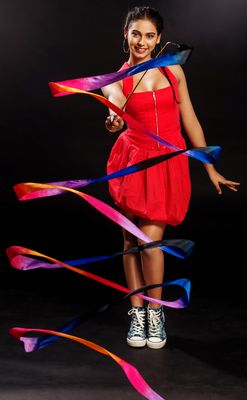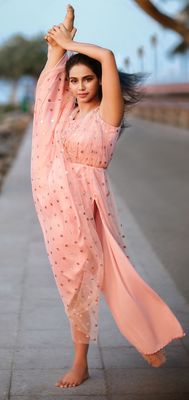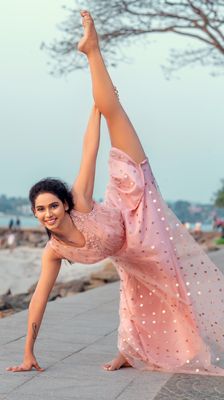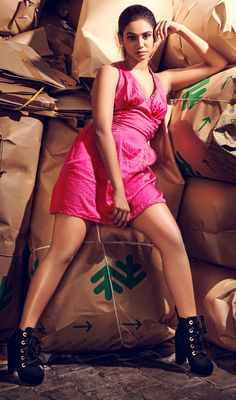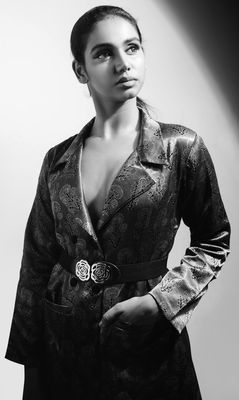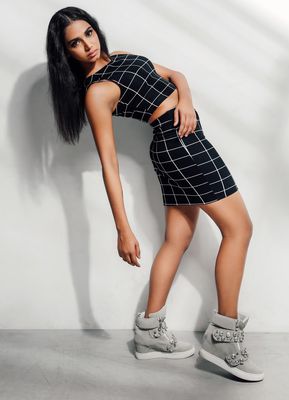As the countdown starts for the opening of the 2010 Commonwealth Games in New Delhi, 60,000 spectators clap the seconds away. An 11-year-old girl in the crowd goes into a trance and visualises herself leading the Indian contingent, the tricolour held proudly in her little hands. Her father Gundlapally Ramalinga Reddy smiles knowingly. He had taken his daughter, who was into gymnastics, to the Games with the hope that she understands what it means to represent the nation. And it worked.
“I really wanted it,” recalls Meghana Reddy Gundlapally. “I was in love with rhythmic gymnastics and the moment fuelled my passion.” In the 2018 Commonwealth Games in Gold Coast, Australia, she was the only gymnast representing India. “My father runs an HR consulting company and he has seen people from different career backgrounds,” says Meghana, 21. “He said I could finish studies at any age, but had to decide on sports early on. He supported me when I took up rhythmic gymnastics. One of the biggest lessons he taught me was to stay calm no matter what, and that is important when it comes to gymnastics.”
Dressed in a pair of sweat pants and a casual black jacket, Meghana appears sylph like as she, almost involuntarily, goes into an en pointe position just before entering the car at the Cochin International Airport. “I tend to do that a lot,” says Meghana, who is fresh from a podium finish at the Fifth Friendly International Tournament in Italy. She checks her phone, which had already started chirping. She speaks in Telugu, and by the tone of the conversation, it sounds like mommy’s call. “I am super close to my mother; I tell her everything. She has taught me everything about being an adult; she is like a walking guide of ‘Adulting 101’,” she says.
Meghana is coming to the shoot straight from a training session in Chennai. “The strength conditioning session was important as it is rare that I get this sort of training from professional coaches,” she says. “There are many things that I do on my own, pertaining to styles and techniques, but I think it is essential to take into account other aspects of the sport like strength training and mental conditioning. Just because the sport screams beauty, it doesn’t mean that it is not challenging; it can get physically and mentally taxing. Also, everything beautiful comes with a heavy price tag.”
Go home, you are too old for this
“This is the first time I am wearing fake eyelashes,” Meghana tells the makeup artist as he fixes it. “I always do my own makeup; just a little concealer, some foundation, eyeliner and lip colour. Nothing more.” She seems to like the new look, for she kept opening the front camera of her phone to see every tiny development on her face.
Draped in a sleek black dress, Meghana looks calm and composed. Her feet in en pointe position again, she goes for a stretch before the first set of photos. The photographer shouts “Ready?”, and with her head held high, she gracefully walks to the shooting floor. And without wasting much time, she gets into character. As she confidently arches her back and lifts her leg, there is elegance oozing in her every move. One could tell that she loves the lights and the camera. But her love for rhythmic gymnastics surpasses all that.
As a five-year-old, Meghana loved performing in front of people. Not rhythmic gymnastics, though—that came later in life—but dancing. “I learned Kuchipudi from Shobha Naidu—one of the foremost Kuchipudi dancers of India—for five years since the age of five. I think the dance training has helped me immensely when it comes to maintaining my balance,” she says. Before getting into gymnastics, she tried different sports like badminton, basketball and swimming. “I could never stick to any of them,” she says. “I used to go play or train for a bit and then shift to the next event. I thought my affair with gymnastics would also be shortlived.”
It all started in 2010 when she saw her younger brother Suhit jumping on a trampoline at the R.B. Stadium in Hyderabad. She had gone there to pick him up after classes. “I saw that he was having fun and I, too, wanted to try it out. So, the following day I went to his coach, Brij Kishore. The coach told my father that I was too old for it, but I started training anyway.” Training along with Meghana then was B. Aruna Reddy, who became the first Indian to win a medal (bronze) in the 2018 World Cup gymnastics in Melbourne. The focus soon shifted to rhythmic gymnastics. “I started following rhythmic gymnasts around the world,” she says. “I tried out several techniques on my own, watched a lot of videos on YouTube and started following the sport very closely.”
Rhythmic gymnastics is one of the two women-only clubs in the Olympic Games; the other being synchronised swimming. Artistic gymnasts perform on equipment whereas rhythmic gymnasts perform with it. The twirls, the subtle nuance of a properly arched back, the sinuously curved leg, the flamingo-like balance, the right lines and jumps—all the elements that make this sport a spectacle.
When Meghana took up the sport, it was relatively non-existent in India. It had no funding and no support whatsoever. But she never regretted her decision. “When I started, there was no coach specific to rhythmic gymnastics in the country,” she says. “I went to the US for my first international training. When I got to the club I had booked for training, the coach said she could not take me. She said I was too old to learn the basics and that I won’t be flexible. But I was not ready to give up, and we found another club in California where I started my training.”
After the short training in the US, where she did her basic levels, Meghana went to the UK for a month. Both Meghana and her mother stayed in a small town in Wales. “It was an eventful month,” says Meghana. “I have so many funny stories but one that we still laugh about concerns the man who lived next room. The weather was cold and we were freezing. My mother and I noticed that whenever our neighbour left the building, the heater would go off. We were so mad because we thought he had been switching it off. So, one day we started banging at his door. A really tall man, shirtless, opened the door and he looked confused, seeing two short foreign women shouting at him. It took us a while to realise that he did not understand a thing we said. When we realised that the building had a central heating system, you had to see the look on our faces.”
After Wales, Meghana moved to London in 2013; she was there for a year and a half. “I passed level nine in rhythmic gymnastics there. London was like home for me and I enjoyed every bit of my training. I liked how they had a systematic approach in their training and this helped me a lot in improving my techniques,” she says.
She got back to Hyderabad after that and started participating in competitions within the country. “Nobody knew me back then and nobody probably knew the sport either. I did not even have a proper place to practise. But I saw beyond all the impossibilities, kept training and I started participating in various competitions. When I am training, I am a different person altogether; I am completely focused,” she says.
One major putdown she faced was when people told her that she was not fit for the sport and that she should give up fighting for it. “People pointed fingers at my age and my weight. They said that I would never achieve anything in this sport. I am glad I could prove them wrong,” she says.
Meghana continued her academics by joining an open school programme. “People often questioned my parents for letting me take up this sport. It wasn’t just another hobby for me and I was strongly convinced about it. I finished my 12th boards only recently, when I should have done it a couple of years back. But I don’t regret anything. I carried my books even while travelling for competitions so that I could study for my tests during the breaks. People only see the glamour and glitter bit of this sport, not the hard work that goes in and the sacrifices that athletes make,” Meghana says.
According to her, rhythmic gymnastics is an excellent opportunity for young girls to express themselves. “But it is not just about ribbons and rhinestones; it is also a tough sport and needs exceptional dedication for athletes to stay lean, flexible and strong, all at the same time,” she says.
Although she wants more girls to pick up rhythmic gymnastics, she also cautions that it is a super expensive sport. “A basic leotard (the one-piece garment that performers wear during the competition) costs about €400-700. There are more expensive ones,” she says. Meghana’s pink and peach leotard, that costs around €500, has Swarovsky crystals on them. “My mother carries it in her handbag whenever we travel for competitions. There is a reason for that. Once when my father and I were travelling back to India from Greece, our bags got stolen from the cab when we stopped to go see a dock on the way to the airport. My bag had three leotards and all three were expensive. Since then, we keep it close to us,” she says. The training mat costs around Rs19 lakh. One also has to spent on equipment like clubs, ribbon, hoop, rope and balls.
As Meghana opens her suitcase, the entire crew gets distracted by all the bling. Shiny golden and red balls, glittery clubs and a ribbon that looked absolutely magical. “Let us do a shot with the ribbon,” the photographer suggests, and Meghana’s face lights up. As she marches pertly out on the floor with the ribbon trailing obediently behind, the crew looks at her in awe. She begins to pose and the ribbon suddenly appears to take on a life of its own, swirling seductively in increasingly wide spirals. “I am good with clubs, balls and hoops, but the ribbon is quite hard. During competition, gymnasts should make sure that the ribbon does not touch the ground and that it should be constantly moving. I have got tangled up in the ribbon a couple of times,” she says. As she kept moving, one could see not the ribbon or the girl, but both, as a unit in a single flowing composition. Enchanting.
The hurdles and the hope
“I was closely following 2016 Rio Olympian Varvara Filiou from Greece. From her social media posts, I understood that she was training till 2017 and then she stopped. I sent her a text immediately. She had her doubts in the beginning and then she said that she wanted to meet me,” Meghana says. Meghana wasted no time in getting to Greece. Varvara conducted a small test to see if the Indian girl had what it takes to excel in the sport. She was convinced and agreed to coach Meghana.
But, during the 2018 Commonwealth Games, both Meghana and Varvara received a shock after they landed in Australia: they were told that Varvara cannot access the Commonwealth Games village, or the training facilities. Only Meghana had the accreditation. This meant that she was on her own in the week leading up to the event. “For an entire week I stayed alone, trained alone and on the day of the competition, I competed alone,” she says.
Meghana managed to secure the 18th place finish despite the maelstrom in the background. Surely, it wasn’t one of her best performances. “The seconds of silence just before the music started playing was terrifying. Everyone had so many expectations. The mental pressure was weighing me down. And, the worst part is that I never opened up about it at that point. It took me a lot of time to talk about it,” she says. It was just weeks before the Commonwealth Games that her first gymnastics coach Brij passed away after battling cancer for some time. This had also affected her performance. “All of us have battles that we need to fight; some on our own and the others with some help,” she says. But things took a positive turn after the Commonwealth Games, when Go Sports Foundation came on board. Their team now takes care of her nutrition and physiotherapy.
In 2019, just before the World Championship, Meghana was down with dengue. The competition was the only way she could get a ticket to the 2020 Tokyo Summer Olympics. “Tough luck but I think everything happens for a reason. I am still young and the world is full of opportunities,” she says. Meghana is now focused on Commonwealth Games 2022 and Summer Olympics 2024.
“It is nice to see that nowadays parents are offering support to their children in pursuing sports. Most of them are fully convinced that sports can be a full-time career opportunity in future. I just hope that rhythmic gymnastics would have better days in the future,” she says.
As we reach the final leg of our shoot at the Fort Kochi beach, Meghana’s fluidic movements gather quite a crowd. The waves are licking at the golden sand under her feet and the crimson orange sky gives an ethereal hue to her peach flowy dress. She contorts her back and stretches out her arms without any care. And just as the sun sets, she breaks into a vertical split. The flash fires; it is picture perfect. But Meghana doesn’t stop there. She sways and goes into her favourite en pointe position as if she was tiptoeing to watch the sun disappear into the sea. She wants to go on but the crew is ready for a wrap. Meghana longingly looks at the beach sand and one could tell that she was not ready to leave.
They say, if it is pretty, it is not a sport! But looks like rhythmic gymnastics provides just the right counterpoint to the rest of the games. “Most gymnasts have an early retirement which is why trainers insist on starting early. I will stop playing this sport one day, but I can never unlearn what it taught me. I want our country to start talking more about this sport and I hope I could bring about that change,” Meghana says on the way back to the studio. Let us hope so.
Apparatus:
Rope: Usually made of hemp or a synthetic material. Its length is in proportion to the height of the gymnast. When the middle of the rope is held down by the feet, both ends should reach the gymnast’s armpits.
Gymnasts swing the rope, throw and catch the rope, make figure-eight-type circling movements and more.
Some of them leap and jump through the rope while they are holding it with both hands.
Hoop: Made of wood or plastic. The hoop is 0.7 to 0.8m in diameter. During performances, gymnasts toss and catch the hoops.
Ball: Made with rubber or a synthetic material and is roughly around 0.2m in diameter. Tricks such as bouncing and rolling besides throws are performed by the gymnasts using the ball. It is usually around 14 ounces.
Clubs: Resembles bowling pins and both the clubs are of equal length, around 0.4m to 0.5m. They are made from wood or a synthetic material. Gymnasts use the clubs to do tricks like circles, mills, throws and catches. Each club weighs around 150g.
Ribbon: Single two-inch-wide satin strip, about 6cm long, connected to a slender wooden wand. Gymnasts accentuate their moves using the ribbon; they create patterns, including spirals, circles and snakes. The gymnasts must keep the ribbon in motion throughout the entire routine; also, the ribbon should not touch the ground at any point during the performance.
My fitness regime:
My training schedule usually keeps changing, depending on the competition season. Now, I do four hours of rhythmic gymnastics training, two hours of strength and conditioning which includes bodyweight exercises. I also have two hours of ballet training.
The strength and conditioning routine changes every month and the ballet schedule is different every week. It all depends on the areas where I need improvement and extra care.
What’s on Meghana’s plate?
My diet plan, like everything else, keeps changing every month depending on my training schedule. We also go for a body scan every week to keep track of the progress with regard to my body fat proportion and muscle mass. The changes in the diet are based on the scan results.
Early morning drink: Celery juice
Breakfast: Either eggs or stir-fried vegetables with boiled beans, channa or lobia
Lunch: Salad with some kind of protein like chicken, fish, turkey or egg
Snack: I usually have fruits. Dried and fresh ones
Dinner: It is again salad with chicken, fish, turkey or egg
Apart from this, I also drink a lot of water during the day. Sometimes, I add chia seeds and lemon to it. I also love espresso shots.
At a glance:
Do you have a pet name?
Yes. Everybody at home calls me ‘Mini’
Funny incident.
There are so many! In one of my initial competitions, I rolled my hoop on the floor and the plan was to throw it with my leg the moment it rolled back to me. But somehow, I missed and the hoop rolled right out of the mat. I didn’t know what to do. The music kept on going and I ran behind my hoop. It was embarrassing then, but it is funny now.
A show you binge watched.
My all-time favourite is F.R.I.E.N.D.S.
Your first crush.
It was a long time back when I was in school. It was one of my classmates.
A lie you told your parents.
I told them that there was no alcohol at our high school fresher’s party. (Giggles.)
A song you keep humming.
‘City Slums’ by Raja Kumari
Your idea of a perfect getaway.
A resort or a beach. I wouldn’t get into the water but I like to sit and watch the waves.
One thing you always wanted to do but never could.
Skiing. I had the opportunity but I never got myself to do it.
A weird habit.
Sitting in splits while watching TV, eating food or doing my homework.
Something you would tell your younger self.
Follow your dreams and don’t let what people say stop you from pursuing it.
A person you look up to.
There is no one person. I look up to my parents.
Comfort food.
Raw bell pepper.
Three wishes.
I would have asked for travel but I already do that. Eating without getting fat, getting to watch TV shows without the wait for the next season and well… world peace, I guess.



